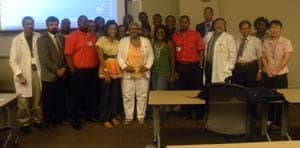Students Gain Research Experience through UAMS Internship Program
Sept. 1, 2009 | For 15 minority college and high school students, a summer working in research labs at the University of Arkansas for Medical Sciences (UAMS) could be the springboard that interests them in a career in health care. That was the goal of the first summer research internship program sponsored by the UAMS Center for Diversity Affairs, the Winthrop P. Rockefeller Cancer Institute’s Arkansas Cancer Community Network and the National Cancer Institute’s Center to Reduce Cancer Related Health Disparities. The program wrapped up with a recent reception where the students made short presentations about their laboratory experiences. Billy Thomas, M.D., associate dean for diversity affairs at UAMS, said participation in research activities could help those students develop an interest in the biomedical sciences and encourage them to pursue a career in health care. “Data from the Association of American Medical Colleges tells us that health-related work experience is one of the top factors that influence students to study medicine regardless of their race or ethnic background,” Thomas said. “The end result is a larger, more competitive pool of applicants to professional schools not only in Arkansas but also across the nation – coming at a time when we need more health care professionals.” Ten college undergraduates and five high school students were selected to spend several weeks working in a UAMS lab under the mentorship of a researcher. Alexei Basnakian, M.D., Ph.D., an associate professor in the Department of Pharmacology and Toxicology of the UAMS College of Medicine, hosted University of Central Arkansas student Wilson Alobuia in his toxicology lab. Alobuia had not been in a lab before, Basnakian said, and was put to work collecting data for a research project involving human vascular endothelial cells. Basnakian praised the student’s attitude as well as his work, which produced direct evidence about the role played by a DNA-degrading enzyme endonuclease G in cellular damage. Alobuia is a co-author on an abstract about the research submitted for the Arkansas Biosciences Institute fall symposium. The student will represent the research team to present the poster at the symposium in Jonesboro. That puts Alobuia ahead of schedule for another of the internship program’s goals: to complete a project and have it published. Thomas said he hopes to see students returning during holiday breaks from school to continue working with their UAMS mentors and gaining further experience. Alobuia is planning to do just that, Basnakian said. He agreed that the internship program could well be a catalyst to interest students in health careers. “This program is an excellent platform for motivated students like Wilson,” said Basnakian. “There is no other way to teach students to do research than by bringing them to the lab and exposing them to all the challenges and rewards of science.” Links on This Page UAMS Center for Diversity Affairs: http://www.uams.edu/com/cda/ |
